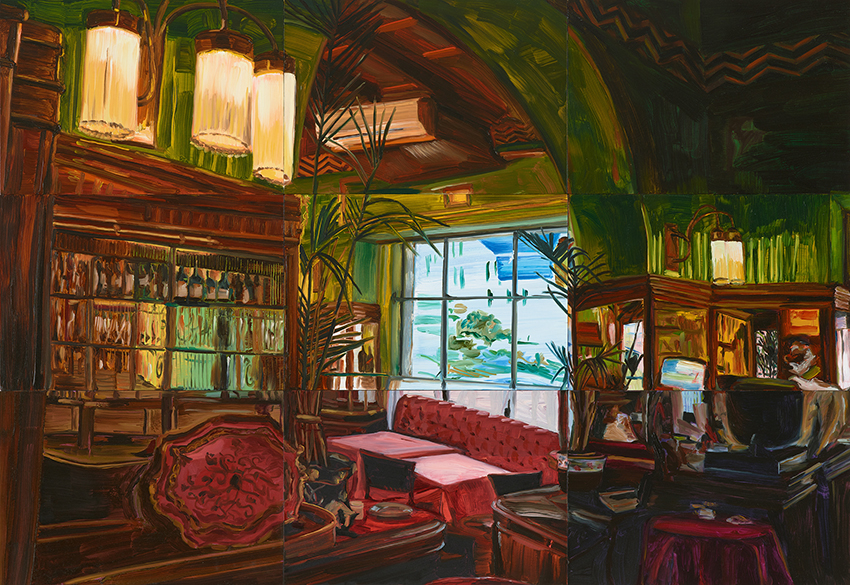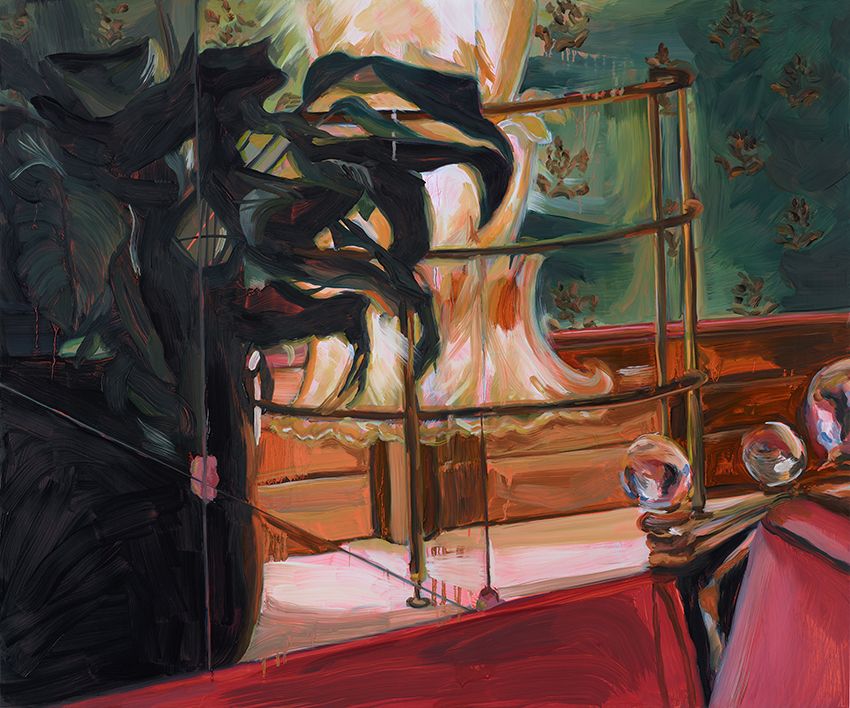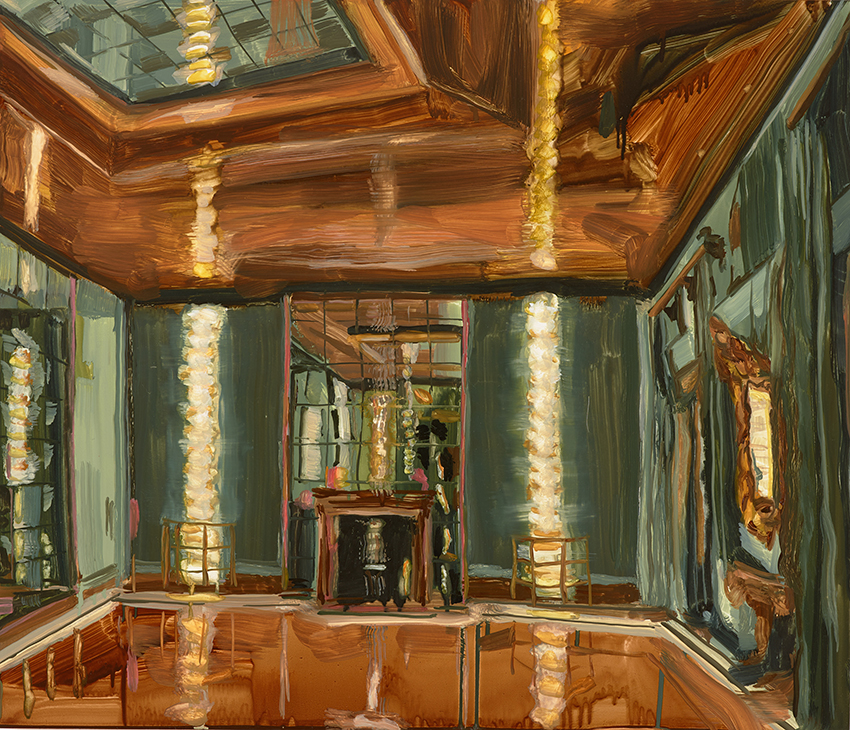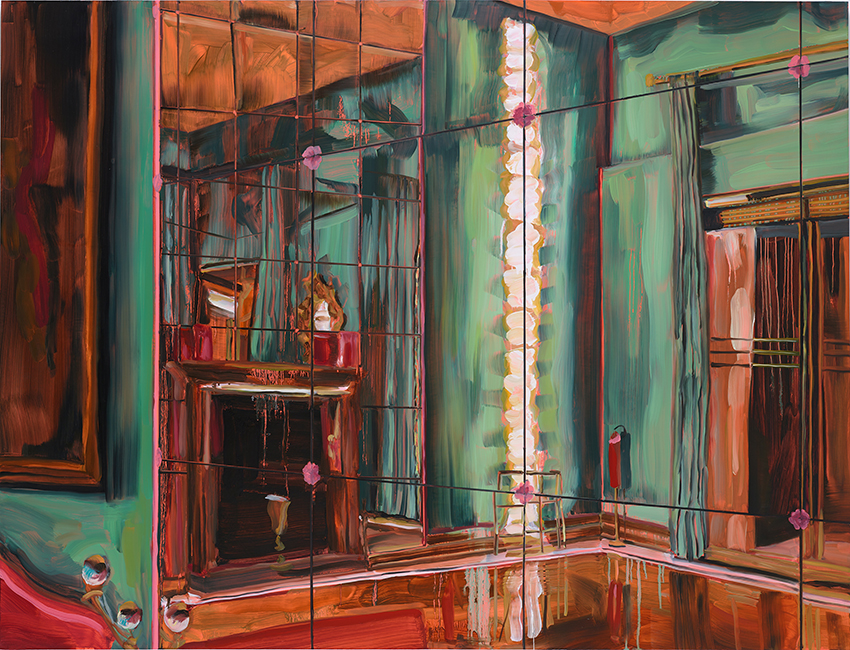It’s a seemingly rare sunny summer’s morning when I go to visit Anna Freeman Bentley’s studio in Hackney Wick, London. And she’s on top form, brimming with energy as she leads me at pace through the streets of this still-gentrifying part of East London. It looks like the set of a fashion shoot round here – edgy industrial estates and extensive graffiti, with hardly a car or person out on the streets, but like much of Hackney, it’s looking so much smarter and brighter than it did just a decade ago, the Olympic Park looming in the distance. It’s no surprise to find a block of artist studios in this kind of location – so often you find them outside the desirable residential, commercial and retail districts, until, that is, they eventually become desirable and the gentrification process gains the upper hand.
Across the different bodies of works that she has made to date, architecture is a unifying thread. Best known for her depictions of interiors – though she is no stranger to facades and exteriors too – she has variously painted everything from modernist architecture and Victorian houses to grand Venetian baroque banqueting halls. She’s clearly drawn to different scales of interior, with some cosy dark bars and intimate restaurants seeming in complete contrast to palatial spaces sparkling with chandeliers and mirrors. And the contents of buildings are of interest to her too – firstly the fixtures and fittings such as fireplaces and lighting, floorboards and wallpaper, windows and shutters, but also furniture and homewares ranging from armchairs to pot plants and ornaments.
One of her breakthrough series of works depicted a second hand shop, a barn-like space filled from floor to rafters with bric-a-brac and almost antiques. Many of us share Freeman Bentley’s fascination with, and love of, such places – entering an Aladdin’s cave and looking out for something amazing, unusual, vintage or simply a bargain. These are rooms filled with people’s memories, the objects imbued with their own history often spanning many generations. And it’s these stories – or unknown stories – that are so engaging, of family heirlooms that have been discarded, souvenirs brought from abroad at specific moments in history, things given away, stolen, sold. Freeman Bentley’s paintings capture the aura that such shops emit – melancholy and magical at the same time. Some objects have more of an aura than others – maybe we could call it character, charm or allure, but some things just resonate, speak to us in ways that other objects don’t. We might just as easily fall for novelty 1980s bubble bath bottles as for Fabergé eggs. It’s why we are a nation of collectors, of charity shop addicts, of bargain hunters. Objects and furniture make, and become repositories of, memories and emotions.
During my studio visit, the artist mentions that she’s planning to visit some brocantes – second hand street markets – in France later in the summer, so perhaps there will be more works to come that follow on from her earlier bric-a-brac works. They have certainly played an important part in the development of her thinking about objecthood and its representation in her practice. In Reality and Fiction (2016), Freeman Bentley presents us with a close-up of an interior – it appears elegant, with stylishly patterned wallpaper, a plant and edges of furniture surrounding an illuminated lampshade. The shadows cast suggest it is a dim-lit room, though we have little sense of the room’s scale from the limited information we are given. Closer inspection reveals a series of thin lines cutting across part of the image vertically and diagonally, suggesting that we might actually be looking at a mirror, with the majority of the painting a reflection, and at the bottom of the image, a sofa or bench in front of it. The reflection, which often offers a glimpse of the wider room in a painting of a close-up interior, here yields little – the reflection is almost as close-up as our ‘real’ view of it. This suggests an intimate space, like being sat in the corner of a hotel bar, but at the same time it’s hard to figure out exactly what is going on – if that’s a skirting board underneath the wallpaper, why is the lampshade so close to the floor? And where’s the base of the lamp? Is it a tall lampshade, continuing out of the top of the image? And where, exactly, is being reflected? Is that a fireguard around the lamp? As the title suggests, what at first seems like a pretty easy going scene turns out to be more complex, gently posing us multiple questions about the nature of the space, the objects in it, and what we are actually seeing.
That Freeman Bentley is interested in getting inside the logic of a space is further illustrated by Interruptions (2016). What at first appears like a unified, coherent view of an intimate country pub or old-fashioned hotel lobby, is, when viewed close up, made up of nine separate panels, each painted discretely, with none of them quite matching up. Each connecting side of a panel involves a series of ‘interruptions’ in the continuity of the image – ever so slight mismatches of angles, shapes, colour, line and form. The scene is visually intense, filled with tropical plants and glowing wall sconces, upholstered sofas and mirrored drinks cabinets. Every surface is busy, every angle has something going on behind it, every visual episode leads to others, and this optical intensity is only enhanced by the artist’s subtle fragmentation of the scene.
Freeman Bentley’s interest is often at this intersection of decoration, furniture and architecture, for just as the things we buy or have in our homes can develop an aura through the relationships we develop with them, so too can rooms and buildings. What are the characteristics or qualities that give certain spaces a particular atmosphere? Well it undoubtedly has a lot to do with the décor – this sends our eyes and minds information about the places we are in; it is also informed by scent, temperature, light, the weather outside, the time of day, by the organisation of things within that space. But as well as all the triggers that come from the room and the environment, we bring with us a whole other set of factors and criteria – what mood we are in, why we are there, what our status is in relation to a place, who we are meeting, how we feel about ourselves, what kinds of personalities we have. Both consciously and subconsciously we assess the things and spaces around us, on a basic level to make sense of them and to navigate around them. But on a much deeper level we are making all kinds of judgements – spatial, social, cultural, emotional, aesthetic, temporal, economic, political. Sometimes we can’t wait to get out of a particular room or building, other times we are quite relaxed there. Some spaces we get to know intimately, others we visit just once or pass through, our brains hardly given chance to process what’s around us.
It is such questions about our immediate environment that Freeman Bentley makes us confront, and from many angles, through her ‘painterly’ paintings. In the work Light Room (2016), we see a rather grand interior. Once again we find unorthodox column-like lighting, and can see the same fireguards around the base as in Reality and Fiction. The mirrors are panelled and we might well begin to wonder if this is the same room viewed from a different perspective. On asking, I discover that the interior is from a hotel in Venice. Freeman Bentley started painting Venice several years ago, fascinated by the idea of ‘spaces of luxury’ and how people’s aspirations to create or own such places – places that often remain pretty much the same for centuries – contrast with the fleeting nature of our lives and the relatively short time we spend in such places, especially in a place like Venice where almost everyone is just visiting. Buildings and rooms are time capsules as well as portals into other people’s lives. Freeman Bentley confesses that she’s always been interested in the idea of being a stranger in other people’s property, especially long after their original owners have gone, and we can all think of experiences of being in other people’s rooms that have made a lasting impression on us in some way or other. ‘I guess that’s where the intrigue is, considering the idea of home as a stranger’, she comments. The artist is also interested in how spaces change their use over time, how they might once have been someone’s home but are now uninhabited, like the bedrooms in a historic palace, or are repurposed, like banks being changed into bars, and pubs into trendy restaurants. Indeed, the relationship between the history of a building, the style of its interior, and our encounters with it can be key ingredients in generating what Anthony Vidler describes as ‘the architectural uncanny’ – curious sensations that we have in response to architecture and interiors.
In another related work, Exchanged (2016), we see what might be another angle of the same room, but this time the colours are more electric, luminescent, and charge the space with a very different atmosphere. Spending more time with the image reveals that we are looking very close up into a mirror, with a painting and item of furniture next to the left-hand edge. Our view of the room is more expansive in this reflection, though we are looking at a very small section of ‘real’ space in the room. Reflections meet reflections which meet yet more, suggesting perception might be just a step removed from other dimensions. There is something uncanny in Freeman Bentley’s works, something that goes beyond describing the atmosphere of a particular room or building, and into the realms of something darker or deeper – one might even describe it as ‘spirit’ – the qualities and characteristics that give a space a sense of life, energy or even consciousness. It’s something Freeman Bentley is exceptionally good at – bringing spirit to, or out of, objects, spaces and places through paint.
A monograph on the artist, edited by Matt Price, is available from Anomie Publishing
Matt Price
Image credits from top to bottom:
Interruptions, 2016. Oil on board, 68 x 99 cm. Photo by Anna Arca. Courtesy of the artist.
Reality and Fiction, 2016. Oil on board, 75 x 90 cm. Photo by Anna Arca. Courtesy of the artist.
Light Room, 2016. Oil on board, 60 x 70 cm. Photo: Anna Arca. Courtesy of the artist.
Exchanged, 2016. Oil on board, 122 x 160 cm. Photo: Anna Arca. Courtesy of the artist.










